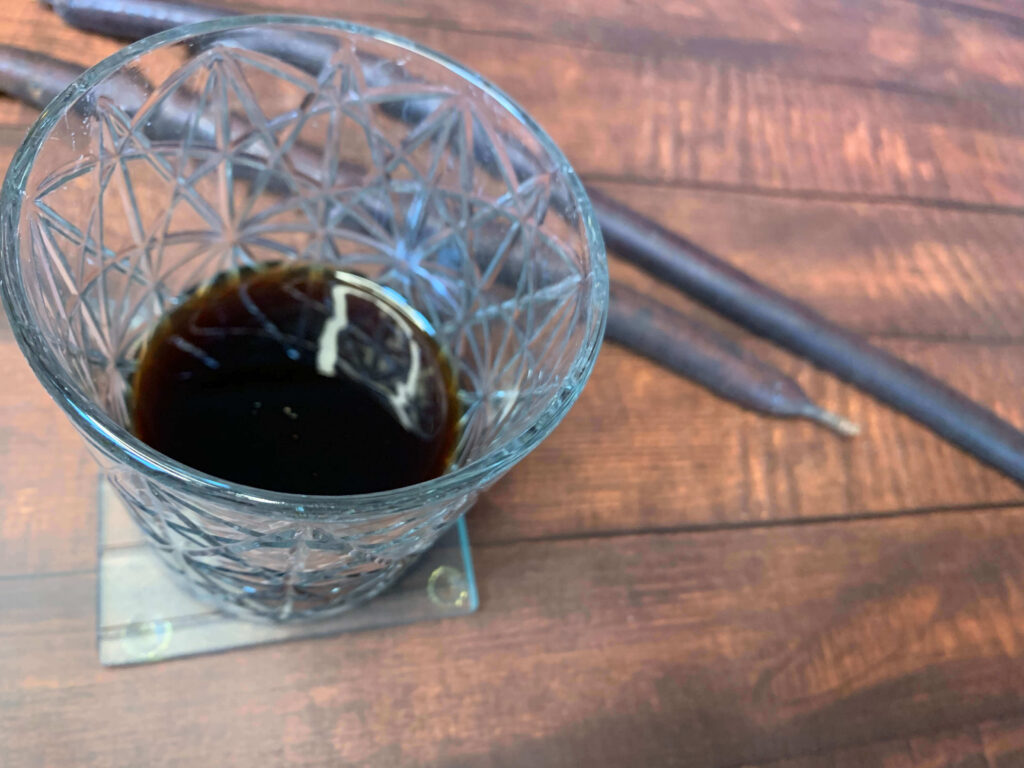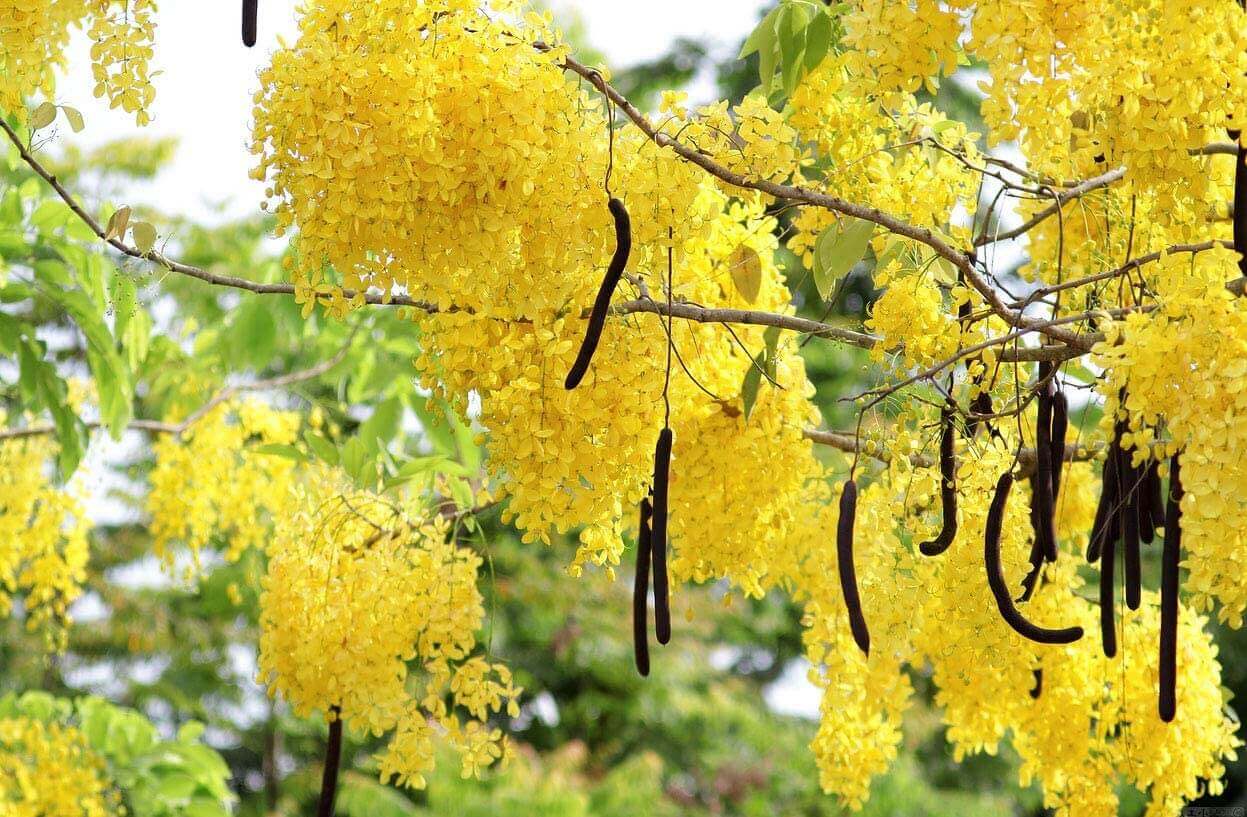The Indian golden flower tree for detoxification.
Amaltas – in sanskrit ‘Aragvadha‘ is a fast growing golden flower tree that is one of the most popular herbal plants known for its medicinal worth and detoxification qualities. It is also referred to as the ‚indian golden shower tree‘ because of its yellow blossoms and is the state flower of Kerala in India.
Amaltas is a medium-sized tree up to 24 m in height that is cultivated almost throughout India. It ascends up to an altitude of 1,220m in the outer Himalayas and is also common throughout the Gangetic valley.
The more known botanical name of this plant is Cassia fistula, which means ‚to kill‘ diseases. Interestingly every part of Amaltas tree contains various phytochemicals.
There are many Cassia species worldwide wich are used in herbal medicine.
Appreciated for its cleansing and detoxifying remedies it has been used since 2500 years. Back in the days chemical remedies such as epsom salt were not available, thus people relied on natures pharmacy. As Cassia fistula contains natural proponents that activate both the small intestines and the colon, it was used for almost all fasting cures and liver cleanses.
All parts of the golden shower tree are used due to their different qualities:
🍃 Amaltas seeds: linoleic acid, oleic, traces of caprylic, vermolic, sterculic and galactomannan
🍃 Amaltas stem bark: fistucacidin, tannins, rhein and barbaloin
🍃 Amaltas leaves: tannins, glucoside and sennsosides
🍃 Amaltas pulp: carbohydrates, protein, leucin, tryptophan and glutamic acid
🍃 Amaltas flower: kaempferol, rhein, fistulin, tetramer and triterpenses
The Cassia fruit’s effects are as characteristic as its appearance – a long black pod – and its unique taste.

Curious to finding out more about Cassia fistula aka Amaltas?
Cassia fistula contains antimicrobial and antioxidant constituents and plays a pivotal role in disease prevention. Various parts of the plant such as stem, leaf, pulp and flower contain different types of therapeutic remedies.
Through its antioxidant activity it neutralizes the attacks caused by free radicals and therefore reduce the risk of disorders.
It is often used as a highly effective laxative that is even safe for children. It is however not recommended to use high dosages of the leaves and bark as it can cause vomiting, nausea and abdominal pain or cramps.
In general medicinal plants contain several valuable ingredients, that play a role in health care, such as the following amino acids: flavonoids, tocopherols and polyphenols.
Studies have proven that extracts from different parts of the plant show high antioxidant activity.
Cassia fistula is used by traditional medical practitioners for the treatment of various diseases.
According to many research studies, it is concluded that Cassia fistula is responsible for various therapeutic potentials such as anti cancer, anti bacterial, anti diabetic, anti fungal activity, anti-itching, anti inflammatory, antioxidant, laxative, wound healing and many more.
The plant is rich in carbohydrates, linoleic acid, oleic acid, and stearic acid. According to Ayurveda the leaves and seeds are acrid, laxative, anti periodic and work as a liver tonic. The leaves and seeds are useful in leprosy, ringworm, flatulence and colic.
It is available as pods or as a paste, first option involves a little more time and has the benefit of freshness.
Guidelines for usage
There’s two different ways of ingesting Cassia fistula, either as disks that are kept in the mouth until dissolved or liquified in water.
Ingest Cassia fistula apart from meals and in small quantities.
Another way to use Cassia is to prepare a drink that has the advantage of better distribution in the body. Liquidized it is able to better bind toxins that may be spread throughout the body.
The laxative effect kicks in between the second and tenth hour after usage.
Instructions for disks
- Take 1-4 disks in mouth, start with one or two disks a day, let the pulp melt on your tongue until there’s only the hard wooden disk left.
- Do not use the seed or wooden disk as the core isn’t edible.
Instructions for pod
- Crack open the pod with a nut cracker and take the whole inside out. You will be abele to take out several disks that are covered in black flesh, the only edible part of the pod.
- Dissolve around 9g tennis ball sized pulp in 100ml lukewarm water and let sit at room temperature for 6 hours or over night.
- Take wide bowl and place a sifter on top, pour Cassia mixture on top and with a hand whisk gently press out the pulp. Continue until only the seeds and disks are on the surface.
- Gently pour a little water on top to get all the remaining pulp off the disks and seeds.
- Pour in your favorite glass and enjoy!
Advice
Refrain from drinking 15 minutes before and after ingesting Cassia fistula for avoiding dissolving the reaction.
Use either in the morning or latest around 4 pm on an empty stomach.
Cassia works gently on the system and it is recommended to take it easy on the day of consumption.
Make sure you have a toilet close to you and be prepared for a good release.
Side effects
Cassia cleanses your body from toxins thus you can expect head aches, nausea, dizziness and/or stomach cramps. After 30 minutes it shall pass, if not make sure you breath deep and rest until you feel better.
In general it can be said the stronger Cassia fistula works and effects your body, the more toxic and concentrated are the toxins in your body. The consequence can be strong smelling slimy stool. Always clean your toilet and hands well of such release of toxins.
Cassia fistula can be stored for several months, ideally in cool temperature. After some time, it can get dry but can be re-humidified before ingestion.

Thanks for the details of benefits of this plants. I am looking for this plant to buy it to grow in my garden.
Where can I order it?
Dear Neema, it really depends where you live. In Europe you can definitely get it either at http://www.nakurapie-shop.de or http://www.jurassicfruit.com
Just look for cassia fistula, they have it as a paste or the whole pod. I love the paste, just make sure to spend the day at home and close to a toilet 😉 If you have any further questions I’m happy to help!
Blessings, Nina
Dear Neema, just noticed you are looking for the whole plant! In that case I’d get the pod and try germinating the seed! I’ve tried it with fruits like sapote mamey and chico and it worked well.